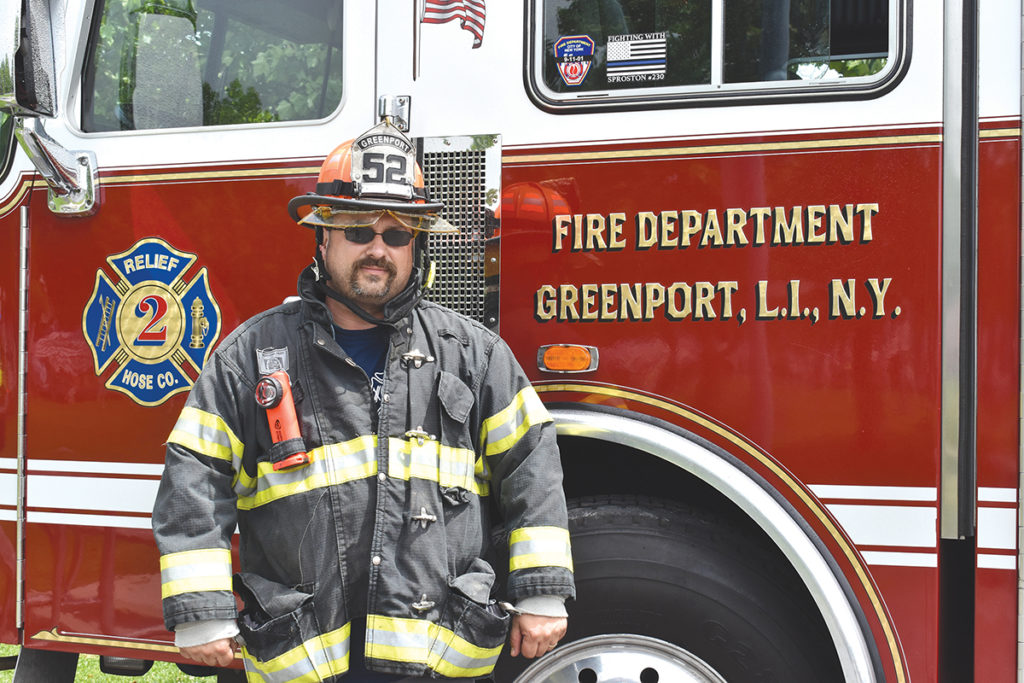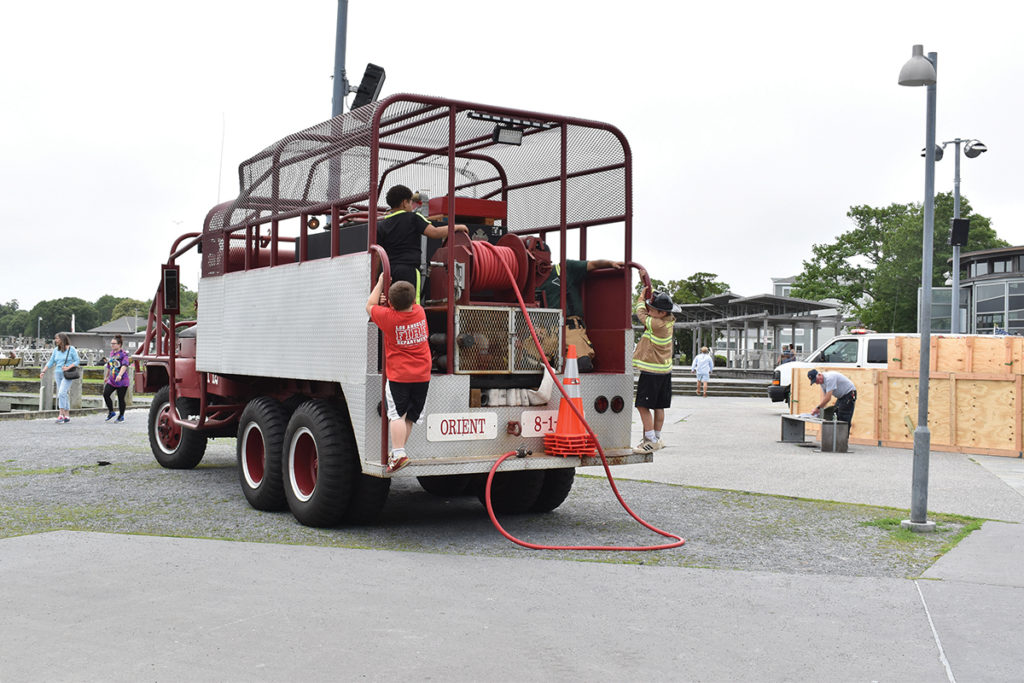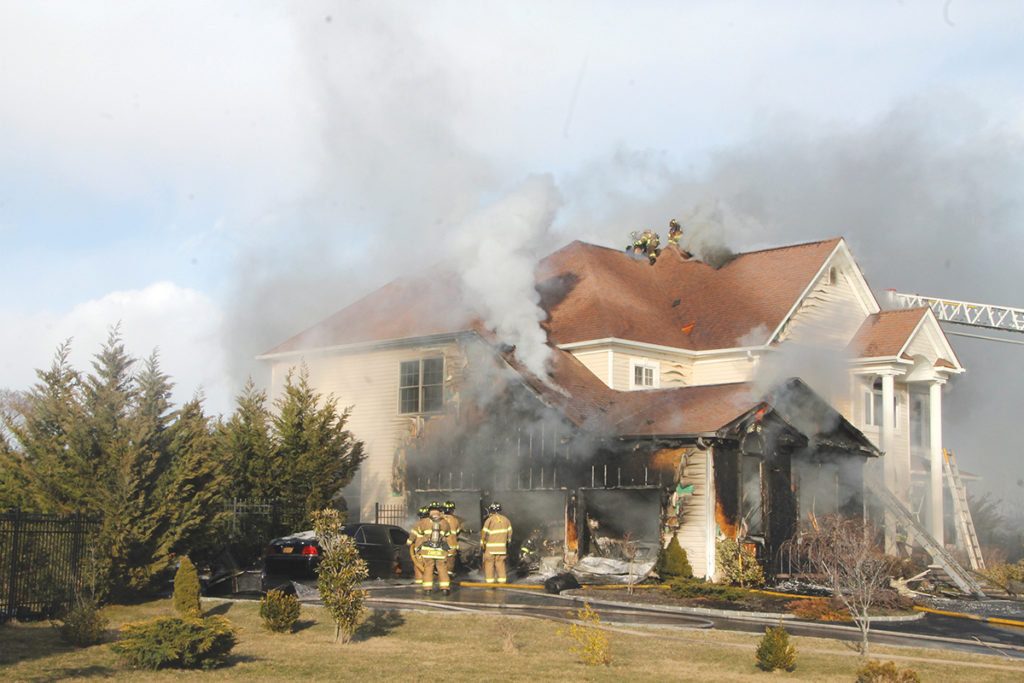North Fork is ‘hurting’ for volunteer firefighters

Greenport Fire Department used to be massive.
Thirty or 40 years ago, there was a waiting list to get in. But now, they’re hurting for volunteers.
“When I joined, we were chock full,” assistant fire chief Jim Kalin said. “It’s dropped since then. It’s been a slow, steady decline in membership.”
Fire chiefs and volunteers have listed a litany of reasons for the drop-off: The rising cost of housing has driven out younger residents and attracted a wealthier demographic that tends to be older or lives in town only part time. The rising costs of living in general means many people must work multiple jobs or longer hours, leaving little free time to spend at their local fire department. Some volunteers also struggle with burnout, exacerbated by heightened requirements for membership and more strenuous demands of short-staffed departments.
But either way, it’s agreed: The East End needs more firefighters.
“Every department on the North Fork is hurting for members,” said Greenport volunteer Robert Corwin, who has watched numbers steadily dwindle since he first joined the department as a junior in 1984.
The Greenport Fire Department has 125 members — a little more than half its authorized strength. The shortage means fewer volunteers respond to each call, often forcing the department to operate with a minimal crew, according to Mr. Kalin. “We can get the job done,” he said. “It’s just a small crew.”

Robert Corwin has volunteered with Greenport Fire Department since he joined as a junior firefighter in 1984. (Credit: Brianne Ledda)
The department, like many others, has come to rely on mutual aid agreements — in which departments assist neighboring jurisdictions — with other towns to fill ranks on some calls. “We’re really depending on our neighbors now,” Mr. Corwin said.
At a recruitment event in late June, he described a house fire just a few weeks earlier where the Greenport chief called East Marion and Southold for aid “right away,” because at eight in the morning, “manpower is going to be light.”
“We all work well together, but … when I first joined, we could have covered that,” Mr. Corwin said.
About 10 years ago, Riverhead had a waiting list, too. The shortage isn’t “too bad” there, according to first assistant chief Joe Hartmann, but they’re down about 20 members — from around 200 usually, to around 180 or 182.
“Nobody’s really knocking the door down to do it anymore,” Mr. Hartmann said, although they’ve been getting “some younger guys” recently.
“During the day sometimes, it hurts us,” he added. Instead of sending out three trucks, they might send out one or two.
In Orient, which has an active roster of about 38 members, Chief Richard Gillooly said his department has been “very fortunate.” The shortage hasn’t really impacted their ability to respond to emergencies, although the Stony Brook University Hospital system, which operates the hospital in Greenport, sometimes helps to fill gaps in emergency medical services.

COVID-19, however, posed a new challenge, with many older volunteers more at risk from the virus. During the pandemic, some volunteers with health concerns chose to cut back their hours, even as others stepped up despite the risks.
“Our oldest member, who happens to be an EMT in his 80s, [would] show up to every call — against better judgment, but it was his choice,” Mr. Gillooly said.
Southold Chief Peggy Killian said her department — which has a “fair amount” of volunteers, but could always use more — stopped taking on new volunteers during the pandemic, reopening ranks to recruits only a few months ago.
“The availability of getting firefighters physicals and all the other stuff was not open to us because everything was closed,” she said. “We did not take any new people in for a little over a year.”
Assistant chief Denise Gluck at Wading River — which, with about 65 active members, is also struggling with a volunteer shortage — said call volume has “significantly increased over the past few years … putting more of a workload on the people available and responding.”
At Wading River, the department has seen a steady increase in calls over the years, from 1,089 in 2012 to 1,228 in 2020. At Riverhead, calls have slowly increased since 2008 but have been relatively stable in recent years.
Some calls are just exhausting, volunteers say. And if there aren’t enough people to share the workload, active members are going to feel the strain.
“You get four, five, six calls in a day and the same couple of people answering; the end of that day, you’re tired,” said David Nyce, another Greenport fire department volunteer and former Greenport mayor. “And that’s just from that, that’s not whatever you do for work, which is also going to be physically and/or mentally taxing.”

Mr. Nyce, who is self-employed, said he feels a responsibility to answer more calls, in part to compensate for the volunteer shortage. He’s been with the department for six years now and he’s witnessed the pressure, especially on chiefs, who go to every call.
“There’s a certain number of years where you’re like gung-ho about it, and you answer every call you can,” he said. “It’s a lot to maintain. I think you see that in our members. You reach a certain point, and you just can’t do it anymore.”
Ms. Killian pointed out that with both spouses in many households working full-time, a lot of people just don’t have time to volunteer.
“There’s a major commitment — you have to get fire school done,” she said. “And if you want to become an EMT or driver, that’s more time. Everything is time, time, time.”
Amos Meringer, the fire chief at Cut-ch-ogue — where although they have enough volunteers, there’s always a “need” — said something similar.
“The work is demanding, the schooling required is extensive and the time commitment is significant, especially in the first year,” he said of volunteer positions.
Mr. Hartmann said “some guys get burned out” on some of the department’s mandated trainings. “The initial stuff you have to do, that’s the hard part,” he said. “The biggest thing is going through fire school.”
That’s a more difficult time commitment for many people who need to work two jobs, he added.

Mr. Gillooly said 25 years ago, new recruits only had to take a course that lasted a couple of hours. Now, it can be a months-long process. New York State requires firefighter volunteers to meet existing residence requirements, active membership requirements set by each department and successfully complete training.
“That seems to be the biggest obstacle right now,” he said. “And then, we do a lot of training like this in-house and that too becomes hard for people working two jobs … We don’t require much, but it is a requirement that you stay proficient with your skills.”
Mr. Corwin has been on the job — along with his wife, who’s a paramedic with the Greenport department — for more than 30 years, while working full-time.
“There’s times where it’s like, you know what, I’m not going to do anything this week because I’m just smoked,” he said. “But we love what we do, and we love helping the community, so we get back into it. But burnout is a big thing, especially for EMTs, because of the stuff they can see at times.”
When considering burnout in her own department, Ms. Gluck thought of emergency medical services — an area where many departments are feeling the volunteer shortage most acutely.
“Some people are EMTs for their career, so this is just an additional task for them,” she said. “But people who have other careers, they can get burned out when they’re doing a lot of call volume and spending a lot of time away from their families.”
Wading River’s department doesn’t “necessarily see that a lot,” but other departments also expressed concern about the lack of EMS volunteers.
“I would say our need is definitely in the EMTs, as part of the rescue squad,” Mr. Gillooly said of Orient. “But that’s basically everyone’s need around here, you know? Fires are few and far between nowadays and with cellphones … they get reported quickly.”
The Stony Brook University Hospital system keeps paramedics on call to help Greenport Fire Department, according to village Trustee Mary Bess Phillips. “The bulk of our calls are emergency medical calls,” Mr. Kalin said, adding that the department could always use more EMTs.
Greenport is among the first departments to open its EMS service so that volunteers can choose to only join the rescue squad and not the fire department, according to Mr. Corwin. This way, people need to complete only one certification, not two.
“So, if you want to be just an EMT you can go and just ride the ambulance, where other departments, you have to be a firefighter as well and a lot of people don’t want to get into that,” he said.
He thinks it’s helped; at a Greenport recruitment event in Mitchell Park in late June, someone asked how to get involved as an EMT. “Firefighting is not for everybody,” he added.
Mr. Corwin said it’s also tougher now, because “it’s busier, especially with the automatic alarms,” and employers aren’t as keen on letting their employees respond to alarms during the day.
“Back in the day, when I first joined, the village was shut down if there was a house fire because all the employees would take off and the bosses were probably with them,” he said. “But now it’s a different atmosphere.”
Especially after the economic devastation wrought by the COVID-19 pandemic, money is tight for many businesses. But, Mr. Corwin said, if employers don’t allow their workers to respond to emergencies during the day, it could ultimately cost them more in taxes if the town is forced to hire full-time firefighters.
“It’s a Catch-22,” he said. “You have to walk a fine line of letting the employees figure out, ‘Do I really need to go to this or not?’ ”
The volunteer shortage has been exacerbated by an aging population on the North Fork. According to 2017 demographic estimates from the Town of Southold, more than 60% of residents are over 45, with the median age around 53.
“If we had a daytime fire alarm right now, the first fire truck out might have volunteers all over the age of 50. We have young guys, but they’re working and all,” said Mr. Kalin, who described the Greenport Fire Department as “an aging force.”
The reason, chiefs and volunteers say, is largely due to the high cost of housing on the East End.
“The price of a house out there’s got to be in the million-dollar range. We definitely don’t have enough young people living out here,” Mr. Gillooly said. “And the ones that are coming out are here in the summer months and going to the city, they’re not year-round residents.”
Ms. Phillips pointed out that a lot of people moving to the North Fork are in their 50s and 60s, looking to get out of the city or retire. Although they might offer volunteer services elsewhere — such as at a library, hospital or school — it’s unlikely they’ll invest time into the fire department. “The physical part of the training of firefighting is strenuous,” she said. “I don’t see some of those that have moved in here that are 65 on up … doing that.”
There’s no easy fix, but Mr. Corwin thinks affordable housing would “absolutely” help; he pointed to efforts to establish an affordable, year-round community on Fishers Island. “I wish we could do something like that in Southold Town or even in the Village of Greenport,” he said.
Some Greenport volunteers were hoping that Vineyard View would be that way, Mr. Corwin said. One of the department’s volunteers apparently applied there but didn’t make the cut. He’s still living with his parents for now, but he might eventually have to move away — costing the department another member.
“It’s getting tough because there’s more second-home owners coming out and they just want to kind of come out and hang out. It’s like their vacation home,” he said. “Because of the cost of real estate, local people can’t really buy anything, and the rents are high, so we’re losing that base as well.”
Many departments think the solution may lie in outreach to local schools.
Mr. Nyce said Greenport is trying to rejuvenate its junior program by reintroducing programs to the local school district, which is “tough … because the school has its own set program.”
“We have to do it when they’re not in session,” he said. “We’re trying to [work] our way back in because it is a big part of the community and it covers a lot of ground for kids — physical, mental, situational awareness — all that stuff.”
Ms. Phillips also emphasized the importance of involving local schools, saying she’d “really like” the Greenport school district to reach out to the fire department and discuss student involvement.
“In order for an organization to grow, it always needs to have a continuous base to encourage volunteers,” she said. “The best way to do that is to start when they’re young. I know the fire department reaches out to the school, but I think it’s time the school started reaching out to the fire department.”
In the meantime, departments are focusing efforts on recruitment and raising awareness about the need for firefighter volunteers. Greenport Fire Department held a family-themed event in Mitchell Park in late June with a firefighter maze for children, firetrucks and plenty of volunteers.
One message members want to get across is that volunteers don’t all have to commit to fighting fires.
“You don’t have to actually be physically involved in the firefight,” Mr. Corwin said. “There’s other things you can do at a fire scene like, you know, go into the firehouse and fill air cylinders or bring water to the scene.”
There’s driving, administrative work, fundraising, musical bands and other ways to get involved. Plus, there’s some perks. For instance, New York offers a Length of Service Award program that provides pension benefits to volunteers based on their years of service.
“I would like to emphasize that joining is like having another family,” Ms. Killian said. “You work together as a team and it’s really enjoyable. It isn’t like you’re joining and all that’s expected is work, work, work … There’s a lot of other fun things we do.”








